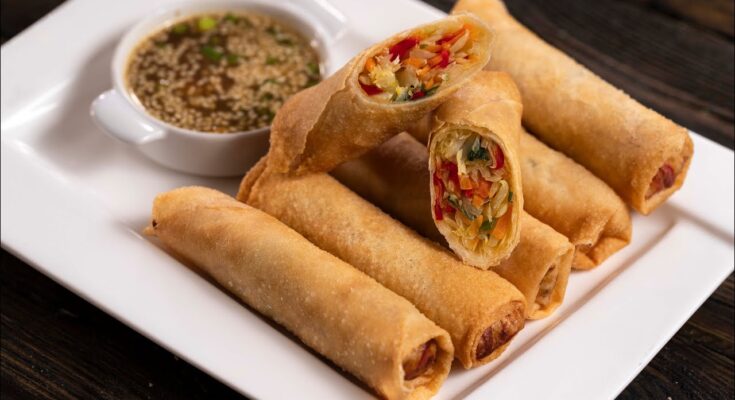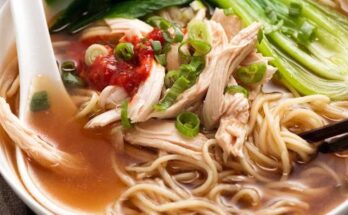Vegetable Egg Roll Recipe: Vegetable egg rolls are a crispy, golden-brown snack or appetizer commonly found in Chinese-American cuisine. They are essentially a delicious wrap filled with seasoned vegetables, then rolled up in a wheat-based wrapper and deep-fried or air-fried until perfectly crisp. Unlike traditional spring rolls, egg rolls tend to be a bit thicker with a bubbly, crunchy exterior and a heartier filling. These tasty treats are perfect as party starters, snacks, or side dishes to a full Asian-inspired meal.
What makes egg rolls particularly appealing is their flexibility—you can stuff them with virtually any combination of vegetables, and they still come out tasting amazing. Think shredded cabbage, carrots, bell peppers, bean sprouts, and onions, all sautéed together with garlic, soy sauce, and a touch of sesame oil. That savory aroma as they fry is enough to make anyone hungry.
Vegetable egg rolls aren’t just tasty—they’re also a great way to get more veggies into your diet in a fun and flavorful form. Plus, you can easily customize them to fit your dietary needs: make them gluten-free, vegan, or even baked instead of fried. Whether you’re cooking for your family or entertaining guests, this recipe is a guaranteed crowd-pleaser.
Why You’ll Love This Recipe
There are countless reasons to fall in love with homemade vegetable egg rolls, and we’ll break down the main ones for you right here:
- Easy to Make: You don’t need to be a professional chef. With simple chopping, sautéing, and rolling, you’re on your way to homemade magic.
- Customizable: This recipe is flexible. You can swap out ingredients to match what’s in your fridge or to suit your taste.
- Crispy & Delicious: That satisfying crunch when you take the first bite? It’s unbeatable.
- Great for Meal Prep: Make a batch and freeze the extras for quick snacks or meals during the week.
- Family Favorite: Even picky eaters love these little pockets of flavor.
- Healthier Option: When you make egg rolls at home, you control the oil and ingredients—no more greasy takeout guilt.
If you’ve ever wanted to recreate the magic of takeout egg rolls in your own kitchen, this step-by-step guide will walk you through every detail, from ingredients to wrapping, frying, and serving.
Ingredients You’ll Need
Before we dive into cooking, let’s go over everything you need to make these crunchy, flavor-packed rolls. The key is fresh, colorful, and crisp vegetables.
Fresh Vegetables
The heart and soul of this recipe lie in the fresh vegetables. Here’s a list of the most common and recommended vegetables you’ll want to include:
- Cabbage (green or Napa): This is the bulk of the filling. It holds up well during cooking and offers a satisfying crunch.
- Carrots: Julienned or shredded, they add color and sweetness.
- Bean Sprouts: Optional, but they add a light, refreshing crunch.
- Bell Peppers (red/yellow): For a pop of color and subtle sweetness.
- Green Onions or Scallions: Adds a sharp, fresh flavor.
- Garlic and Ginger: Essential aromatics that bring depth to your filling.
Feel free to experiment based on your taste. You can add mushrooms for a meaty texture, or spinach for a healthier twist. The goal is to mix colors, textures, and flavors that complement each other.
Wrappers and Fillings
You’ll need egg roll wrappers, which are square, thin dough sheets made from wheat flour and eggs. They’re different from spring roll wrappers, which are thinner and often rice-based.
- Egg Roll Wrappers: You can find them in the refrigerated section of most grocery stores or Asian markets.
- Tofu or Paneer (Optional): For added protein, these can be diced and pan-fried before mixing with the vegetables.
- Cornstarch Slurry (1 tbsp cornstarch + 2 tbsp water): Used to seal the egg rolls before frying.
Oils, Sauces, and Seasonings
Flavor comes from the right combination of sauces and seasonings. Here’s what you’ll need:
- Soy Sauce: Adds that umami richness and saltiness.
- Sesame Oil: A little goes a long way—adds a nutty depth to the flavor.
- Salt & Pepper: For basic seasoning.
- Chili Flakes or Sriracha (optional): If you like a bit of heat.
- Vegetable Oil or Peanut Oil: For frying.
You can also add hoisin sauce or oyster sauce if you want extra savory flavors.
Optional Add-ons and Variations
Want to switch things up or cater to specific diets? Try these:
- Add glass noodles for a twist similar to Thai spring rolls.
- Use mushrooms for a meatier texture.
- Throw in spinach, bok choy, or kale for added nutrition.
- Make it vegan by ensuring wrappers and sauces contain no animal products.
Whether you’re keeping it simple or getting creative, having all your ingredients prepped and ready will make the cooking process super smooth.
Tools and Equipment Required
To get the best results, having the right tools on hand is key. You don’t need a professional kitchen setup—just the basics will do.
Basic Kitchen Tools
Here’s what you’ll need to make your egg roll adventure seamless:
- Cutting board & sharp knife: For prepping all the vegetables.
- Large skillet or wok: To stir-fry the filling evenly.
- Mixing bowls: For prepping and combining ingredients.
- Tongs or spatula: To handle the cooked filling and rolls safely.
- Paper towels: For draining excess oil after frying.
- Measuring spoons & cups: To keep your seasoning balanced.
- Small bowl of water or cornstarch slurry: For sealing the wrappers.
Frying Options – Pan, Deep Fryer, or Air Fryer
You have multiple frying methods to choose from, depending on your preference and available tools.
- Deep Fryer: Best for even cooking and ultimate crispiness.
- Frying Pan/Skillet: Works perfectly for shallow frying with less oil.
- Air Fryer: A healthier alternative that still delivers crunch.
- Baking Sheet & Oven (Optional): For baking as a no-oil option.
Choose the method that works best for you. Just make sure your oil is hot enough before frying—more on that later.
Preparation Before Cooking
Let’s set the stage for success. Prepping everything before you heat the stove will make the process smooth and stress-free.
Chopping and Prepping the Veggies
Wash, peel, and cut your vegetables before anything else. Here’s how to prep them for the best texture and cooking experience:
- Cabbage: Thinly slice or shred for faster cooking and better texture.
- Carrots: Julienne (matchstick style) or use a grater for fine shreds.
- Bell Peppers: Cut into thin strips.
- Scallions: Slice finely to distribute flavor.
- Garlic & Ginger: Mince or grate for a fine texture that blends well.
Once everything is chopped, group your ingredients so they’re easy to grab when you cook. You can even make the filling a day ahead and store it in the fridge.
Setting Up the Wrapping Station
Have your wrappers, cornstarch slurry, and a clean surface ready. Lay everything out neatly:
- Place a damp cloth over the egg roll wrappers to prevent drying out.
- Keep a small bowl of water or cornstarch paste nearby to seal the edges.
- Use a clean cutting board or large plate for rolling.
Once your station is set, it’s time to start cooking!
Step-by-Step Guide to Make Vegetable Egg Rolls
Step 1 – Cooking the Filling
Heat 1 tablespoon of oil in a wok or skillet over medium heat. Add shredded cabbage, carrots, bean sprouts, green onions, and garlic. Stir-fry for 3–4 minutes until the vegetables are slightly tender but still crisp. Season with soy sauce, salt, and a touch of sesame oil.
Step 2 – Cooling the Filling
Transfer the cooked vegetables to a bowl and let them cool completely. This prevents steam from tearing the wrappers.
Step 3 – Wrapping the Rolls Properly
Place a wrapper diagonally on a flat surface. Spoon about 2 tablespoons of filling in the center, fold the bottom corner over, then fold in the sides.
Step 4 – Sealing and Setting Aside
Brush the top corner with water or flour paste and roll tightly to seal. Repeat for all rolls.
Step 5 – Frying the Egg Rolls to Perfection
Heat oil to 350°F (175°C) and fry until golden brown and crisp, about 2–3 minutes per side. Drain on paper towels and serve hot with sweet chili or soy dipping sauce—crunchy, flavorful perfection!
How to Make Egg Rolls Without Deep Frying
Not a fan of deep frying? No problem! You can still enjoy delicious, crispy egg rolls using an air fryer or your oven.
Air Fryer Method
Air fryers are a game-changer for making egg rolls healthier without sacrificing crunch.
Steps:
- Preheat the Air Fryer to 375°F (190°C).
- Lightly Brush or Spray the Rolls: Use oil spray or brush with a thin layer of vegetable oil.
- Place in Basket in a Single Layer: Don’t overcrowd.
- Air Fry for 10–12 Minutes: Flip halfway through cooking.
Benefits of Air Frying:
- Less oil, fewer calories.
- Easy cleanup.
- Still super crispy!
They won’t have the exact same crunch as deep-fried ones, but they’re pretty close—and guilt-free!
Baking Method
Baking is the healthiest option and still yields satisfying results.
Steps:
- Preheat Oven to 400°F (200°C).
- Place Rolls on a Baking Sheet: Line with parchment or foil and brush lightly with oil.
- Bake for 20–25 Minutes: Flip halfway through for even browning.
Pros:
- Great for batch cooking.
- Minimal oil needed.
- No messy frying oil to deal with.
Baked egg rolls are perfect for meal preppers or anyone avoiding fried foods.
Best Dipping Sauces for Vegetable Egg Rolls
No egg roll is complete without a dipping sauce! A flavorful dip brings out the best in every bite.
Homemade Sweet and Sour Sauce
This classic sauce is tangy, sweet, and just right for crispy egg rolls.
Ingredients:
- ½ cup ketchup
- ¼ cup rice vinegar
- ⅓ cup brown sugar
- 1 tsp soy sauce
- 1 tbsp cornstarch + 2 tbsp water (for thickening)
Directions:
- Mix everything except cornstarch in a saucepan.
- Bring to a simmer over medium heat.
- Stir in the cornstarch slurry and simmer until thickened.
Spicy Garlic Soy Sauce
For those who like a little heat, this one’s perfect.
Ingredients:
- ¼ cup soy sauce
- 1 tsp sesame oil
- 1 clove garlic (minced)
- ½ tsp chili flakes or sriracha
- 1 tsp rice vinegar
- Pinch of sugar
Directions:
Mix all ingredients in a bowl and let sit for 10 minutes before serving. Adjust spice to taste.
Serving Suggestions
What to Serve With Vegetable Egg Rolls
Egg rolls may be stars on their own, but when paired right, they turn into an unforgettable meal. Here’s how you can elevate your vegetable egg rolls from a snack to a show-stopping feast.
1. Asian-Inspired Main Courses
- Fried Rice or Steamed Rice: Classic and comforting, rice is the perfect neutral partner to the bold flavors of egg rolls.
- Lo Mein or Chow Mein: The chewy noodles with stir-fried veggies and sauce complement the crispy rolls perfectly.
- Stir-Fried Tofu or Chicken: A protein-packed option that balances the meal.
2. Fresh Sides
- Asian Slaw: A tangy, crunchy cabbage salad tossed with sesame dressing.
- Cucumber Salad: Light, refreshing, and slightly sour—great for cleansing the palate.
- Edamame: Steamed and lightly salted soybeans make a great high-protein finger food.
3. Soups
- Hot and Sour Soup: Its tangy and peppery flavor pairs excellently with fried appetizers.
- Miso Soup: For a lighter, more delicate option.
4. Drinks
- Green Tea or Jasmine Tea: A warm cup of tea balances the richness of the egg rolls.
- Asian-Inspired Mocktails: Try something with ginger, lime, and mint.
5. Party Platters
If you’re serving these for guests:
- Place egg rolls on a platter with dipping sauces in small bowls.
- Garnish with sesame seeds, scallions, or fresh cilantro for visual appeal.
- Add a mix of spring rolls and dumplings for variety.
Presentation matters. Stack the egg rolls neatly, use colorful veggies for garnish, and serve on wooden boards or bamboo steamers for a takeout-chic vibe.
Presentation Tips for Guests or Parties
Hosting a party or a cozy dinner at home? Here’s how to plate your egg rolls like a pro:
- Use Asian-themed dishes: Bamboo trays, chopsticks, or ceramic soy sauce dishes elevate the experience.
- Add fresh herbs: Garnish with cilantro, Thai basil, or microgreens.
- Slice the rolls: Cut a few diagonally to show off the beautiful filling inside.
- Include napkins or hand wipes: Egg rolls can be oily—make it easy for your guests to enjoy them mess-free.
Want to take it even further? Serve your egg rolls with fun labels or mini dipping cups for each guest. Small touches like these leave a big impression.
How to Store and Reheat Leftover Egg Rolls
Refrigeration and Freezing Tips
Homemade vegetable egg rolls store surprisingly well, making them ideal for meal prep or leftovers.
To Store in the Refrigerator:
- Let them cool completely first.
- Store in an airtight container lined with paper towels to absorb excess oil.
- Use within 3–4 days for the best texture and taste.
To Freeze (Before or After Frying):
- Arrange them in a single layer on a baking sheet.
- Freeze until solid (about 1–2 hours).
- Transfer to freezer-safe bags or containers.
Important Tip: If you’re freezing unfried egg rolls, separate them with parchment paper so they don’t stick together. Always label them with the date.
Shelf Life:
- Frozen raw egg rolls: Up to 2 months.
- Frozen cooked egg rolls: Best used within 1 month for optimal taste.
Best Reheating Methods to Keep Them Crispy
You don’t want soggy reheated egg rolls, right? Here’s how to bring back that fresh-from-the-fryer crunch:
1. Oven Reheating (Best for Crispiness)
- Preheat to 375°F (190°C).
- Place egg rolls on a wire rack or baking sheet.
- Heat for 10–15 minutes, flipping halfway.
2. Air Fryer (Fast & Crispy)
- Preheat to 350°F (175°C).
- Air fry for 5–8 minutes until hot and crispy again.
3. Skillet (If You Like Them Extra Crunchy)
- Add a small amount of oil to a skillet.
- Pan-fry each side for 2–3 minutes until crisp.
Avoid Microwaving!
Unless you enjoy soggy egg rolls, the microwave is your last resort. If you must use it:
- Wrap the egg rolls in a paper towel.
- Microwave on medium heat for 1–2 minutes.
- Finish in the toaster oven to restore crispiness.
No matter which method you use, always make sure the inside is heated through before serving.
Nutritional Information and Benefits
Caloric Breakdown
The nutritional value of vegetable egg rolls can vary based on the size, ingredients, and cooking method. But here’s a general estimate for a standard-sized, deep-fried vegetable egg roll:
| Nutrient | Amount (Per Roll) |
|---|---|
| Calories | 150–200 kcal |
| Total Fat | 8–10g |
| Saturated Fat | 1–2g |
| Carbohydrates | 20–25g |
| Fiber | 2–3g |
| Protein | 3–5g |
| Sodium | 300–400mg |
Note: Baking or air frying will reduce fat and calories by 25–50%, depending on the method and amount of oil used.
Health Benefits of Veggie-Filled Snacks
Despite their fried exterior, vegetable egg rolls can offer some surprising health benefits when made mindfully:
- Rich in Fiber: Thanks to cabbage, carrots, and other veggies, these rolls help support digestion.
- Full of Vitamins: Loaded with Vitamin A (carrots), Vitamin C (bell peppers), and folate (cabbage).
- Customizable for Diets: You can make them vegan, low-fat, gluten-free, or even keto with a few swaps.
- Balanced Snack: When paired with a protein-rich dip or side, egg rolls become a well-rounded light meal.
For a healthier version:
- Use less oil or bake them.
- Skip the sugary sauces.
- Add more greens or tofu for a protein boost.
Homemade egg rolls always beat fast food or takeout because you control the ingredients and cooking methods.
Common Mistakes to Avoid
Overfilling the Wrapper
This is one of the most common rookie mistakes—and it can ruin your egg rolls! Overstuffed rolls are:
- Hard to seal.
- Likely to burst open while frying.
- Often soggy inside.
How to Avoid It:
- Use 2–3 tablespoons of filling max.
- Practice wrapping before making a large batch.
- Always cool the filling before wrapping to reduce steam and sogginess.
Frying at the Wrong Temperature
Another big mistake is not checking your oil temperature. If the oil is too hot, the rolls burn outside and stay raw inside. Too cold, and they absorb too much oil.
Ideal Frying Temperature:
350°F to 375°F (175°C to 190°C)
How to Test Without a Thermometer:
- Drop a tiny piece of wrapper into the oil.
- If it sizzles and rises to the top immediately, you’re good to go.
Other Tips:
- Don’t overcrowd the frying pot.
- Let the oil come back to temp between batches.
- Use a slotted spoon or tongs to flip and remove rolls carefully.
FAQs about Vegetable Egg Roll Recipe
1. Can I bake egg rolls without oil at all?
Yes, but they may turn out a bit dry. Lightly brushing or spraying with oil helps achieve a better golden color and crispiness even in the oven.
2. What vegetables work best for egg rolls if I’m avoiding cabbage?
No worries! Try using shredded zucchini (squeezed dry), mushrooms, spinach, or kale. Just make sure to remove moisture so your filling isn’t wet.
3. Can I make sweet versions of egg rolls?
Absolutely! Use fruit fillings like banana and Nutella, or apple and cinnamon, wrap them in the same way, and fry or bake for a dessert twist.
4. How do I stop egg rolls from opening while frying?
Seal them well with cornstarch slurry, roll them tightly, and always place them seam side down into the oil first. Resting the rolls before frying also helps.
5. What’s the best way to pack egg rolls for lunch?
Let them cool completely, wrap in foil or parchment, and reheat in a toaster oven or air fryer at work. Pack the dipping sauce separately to avoid sogginess.
Conclusion
From prepping the vegetables to mastering the wrap and frying them to perfection, every step is a labor of love—and totally worth it. The beauty of this recipe lies in its versatility: you can customize it to your taste, make it healthier by baking or air frying, or double the batch and freeze them for a quick bite anytime.
Not only do homemade vegetable egg rolls taste better than takeout, but you also get to control the ingredients, seasonings, and cooking method. Want more heat? Add chili. More crunch? Add water chestnuts. More protein? Toss in tofu or paneer. It’s your egg roll adventure—make it your own.
So roll up those sleeves (pun intended) and get ready to enjoy one of the most satisfying homemade snacks you’ll ever eat. Trust me, once you make your own, you’ll never look at store-bought egg rolls the same way again.
Bon Appétit, and happy rolling!



